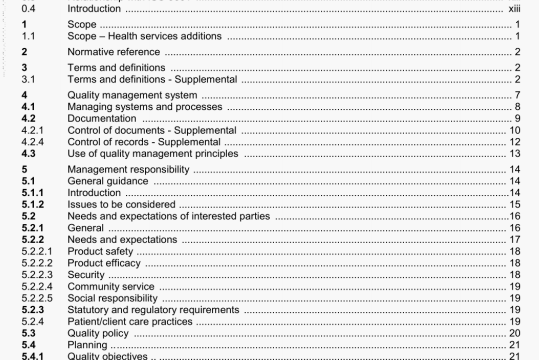ISO IWA 1 pdf download – Quality management systems —Guidelines for process improvements in health service organizations.
Guidance/example(s):
Records differ iron, otler forms of docuineniahon in thai they prove that required isork was performed and record results. Medical records describe the care process for the individual patient. They should allow for an evaluation of how well the process has been carried out, and whether ii has produced the desired oulc’on,e. Eramplex of records to support the qual liv managenu’nt xvvlem. in addition to the patient health record. are: lab results, I11,uging results, admitting records. pharmacy records, purchase requisitions and purchase order, calibration recorcLc for nicasuring devices. qualiir indicator data, forms and checklists once completed. ustomer,,.atieni/cljnj complaints. corrective andor preventive action results records, internal and external audit curser reports. evide,,ce of nlanagt’nwnt reviews, quality planning records, personnel records (including training and conrpetence) records, records of equipment and facility maintenance, hilling and coding records and logs used hi’ various departments.
4.3 Use of quality management principles
To lead and operate an organization successfully, it is necessary to manage it in a systematic and visible manner. The guidance to management offered in this International Standard is based on eight quality management principles.
These principles have been developed for use by top management in order to lead the organization toward
Improved performance. These quality management pnncaptes are Integrated in the contents of this
International Standard and are listed below
a) Customer focus
Organizations depend on their customers and therefore should understand current and future customer needs. should meet customer requirements arid strive to exceed customer expectations.
NOTE This includes interested parties (see 3.1.21,1.
b) Leadership
Leaders establish unity of purpose and direction of the organization They should create and maintain the internal environment in which people can become fully involved in achieving the organization’s obJectives
c) lnvolv•ment of peopi.
People at all levels are the essence of an organization and their full involvement enables their abilities to be used for the oganlzatlon’s benefit
d) Process approach
A desired result is achieved rvse efficienoy when activities and related resoces are managed as a process a) System approach to management
Identifying, understanding and managwig interrelated processes as a system contributes to the organization’s effectiveness and efficiency in achieving its objectives.
measurement of other success factors identified by management.
Information derived from such measurements and assessments should also be considered as input tomanagement review in order to ensure that continual improvement of the quality management system isthe driver for performance improvement of the organization.
5.1.2 lIssues to be considered
When developing, implementing and managing the organization’s quality management system, managementshould consider the quality management principles outlined in 4.3.
On the basis of these principles, top management should demonstrate leadership in, and commitment to, thefollowing activities:
– understanding current and future customer needs and expectations, in addition to requirements;
promoting policies and objectives to increase awareness, motivation and involvement of people in theorganization;
establishing continual improvement as an objective for processes of the organization;planning for the future of the organization and managing change;
setting and communicating a framework for achieving the satisfaction of interested parties.
lIn addition to small-step or ongoing continual improvement, top management should also considerbreakthrough changes to processes as a way to improve the organization’s performance.During such
changes, management should take steps to ensure that the resources and communication needed to maintainthe functions of the quality management system are prowided.
Top management should identify the organization’s product realization processes, as these are directly relatedto the success of the organization.Top management should also identify those support processes that affecteither the effectiveness and efficiency of the realization processes or the needs and expectations of interestedparties.
Management should ensure that processes operate as an effective and efficient network. Management shouldanalyze and optimize the interaction of processes, including both realization processes and support
processes.
Consideration should be given to
– ensuring that the sequence and interaction of processes are designed to achieve the desired results effectively and efficiently, ensuring process inputs, activities and outputs are clearly defined and controlled, monitoring inputs and outputs to verify that individual processes are linked and operate effectively andefficiently, identifying and managing risks,and exploiting performance improvement opportunities,conducting data analysis to facilitate continual improvement of processes,
identifying process owners and giving them full responsibility and authority,managing each process to achieve the process objectives,and
the needs and expectations of interested parties.
ISO IWA 1 pdf download – Quality management systems —Guidelines for process improvements in health service organizations
